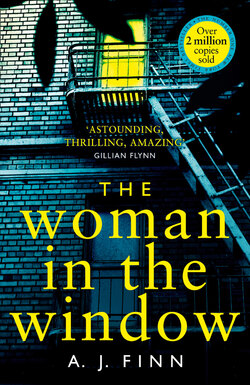Читать книгу The Woman in the Window - A. J. Finn - Страница 9
1
ОглавлениеHER HUSBAND’S ALMOST HOME. He’ll catch her this time.
There isn’t a scrap of curtain, not a blade of blind, in number 212—the rust-red townhome that once housed the newlywed Motts, until recently, until they un-wed. I never met either Mott, but occasionally I check in online: his LinkedIn profile, her Facebook page. Their wedding registry lives on at Macy’s. I could still buy them flatware.
As I was saying: not even a window dressing. So number 212 gazes blankly across the street, ruddy and raw, and I gaze right back, watching the mistress of the manor lead her contractor into the guest bedroom. What is it about that house? It’s where love goes to die.
She’s lovely, a genuine redhead, with grass-green eyes and an archipelago of tiny moles trailing across her back. Much prettier than her husband, a Dr. John Miller, psychotherapist—yes, he offers couples counseling—and one of 436,000 John Millers online. This particular specimen works near Gramercy Park and does not accept insurance. According to the deed of sale, he paid $3.6 million for his house. Business must be good.
I know both more and less about the wife. Not much of a homemaker, clearly; the Millers moved in eight weeks ago, yet still those windows are bare, tsk-tsk. She practices yoga three times a week, tripping down the steps with her magic-carpet mat rolled beneath one arm, legs shrink-wrapped in Lululemon. And she must volunteer someplace—she leaves the house a little past eleven on Mondays and Fridays, around the time I get up, and returns between five and five thirty, just as I’m settling in for my nightly film. (This evening’s selection: The Man Who Knew Too Much, for the umpteenth time. I am the woman who viewed too much.)
I’ve noticed she likes a drink in the afternoon, as do I. Does she also like a drink in the morning? As do I?
But her age is a mystery, although she’s certainly younger than Dr. Miller, and younger than me (nimbler, too); her name I can only guess at. I think of her as Rita, because she looks like Hayworth in Gilda. “I’m not in the least interested”—love that line.
I myself am very much interested. Not in her body—the pale ridge of her spine, her shoulder blades like stunted wings, the baby-blue bra clasping her breasts: whenever these loom within my lens, any of them, I look away—but in the life she leads. The lives. Two more than I’ve got.
Her husband rounded the corner a moment ago, just past noon, not long after his wife pressed the front door shut, contractor in tow. This is an aberration: On Sundays, Dr. Miller returns to the house at quarter past three, without fail.
Yet now the good doctor strides down the sidewalk, breath chugging from his mouth, briefcase swinging from one hand, wedding band winking. I zoom in on his feet: oxblood oxfords, slick with polish, collecting the autumn sunlight, kicking it off with each step.
I lift the camera to his head. My Nikon D5500 doesn’t miss much, not with that Opteka lens: unruly marled hair, glasses spindly and cheap, islets of stubble in the shallow ponds of his cheeks. He takes better care of his shoes than his face.
Back to number 212, where Rita and the contractor are speedily disrobing. I could dial directory assistance, call the house, warn her. I won’t. Watching is like nature photography: You don’t interfere with the wildlife.
Dr. Miller is maybe half a minute away from the front door. His wife’s mouth glosses the contractor’s neck. Off with her blouse.
Four more steps. Five, six, seven. Twenty seconds now, at most.
She seizes his tie between her teeth, grins at him. Her hands fumble with his shirt. He grazes on her ear.
Her husband hops over a buckled slab of sidewalk. Fifteen seconds.
I can almost hear the tie slithering out of his collar. She whips it across the room.
Ten seconds. I zoom in again, the snout of the camera practically twitching. His hand dives into his pocket, surfaces with a haul of keys. Seven seconds.
She unlooses her ponytail, hair swinging onto her shoulders.
Three seconds. He mounts the steps.
She folds her arms around his back, kisses him deep.
He stabs the key into the lock. Twists.
I zoom in on her face, the eyes sprung wide. She’s heard.
I snap a photo.
And then his briefcase flops open.
A flock of papers bursts from it, scatters in the wind. I jolt the camera back to Dr. Miller, to the crisp “Shoot” his mouth shapes; he sets the briefcase on the stoop, stamps a few sheets beneath those glinting shoes, scoops others into his arms. One tearaway scrap has snagged in the fingers of a tree. He doesn’t notice.
Rita again, plunging her arms into her sleeves, pushing her hair back. She speeds from the room. The contractor, marooned, hops off the bed and retrieves his tie, stuffs it into his pocket.
I exhale, air hissing out of a balloon. I hadn’t realized I was holding my breath.
The front door opens: Rita surges down the steps, calling to her husband. He turns; I expect he smiles—I can’t see. She stoops, peels some papers from the sidewalk.
The contractor appears at the door, one hand sunk in his pocket, the other raised in greeting. Dr. Miller waves back. He ascends to the landing, lifts his briefcase, and the two men shake. They walk inside, trailed by Rita.
Well. Maybe next time.
